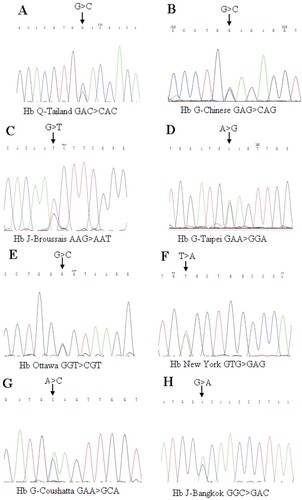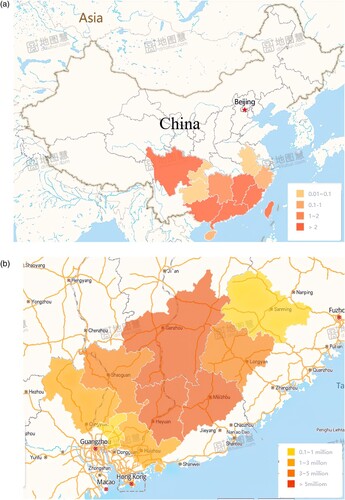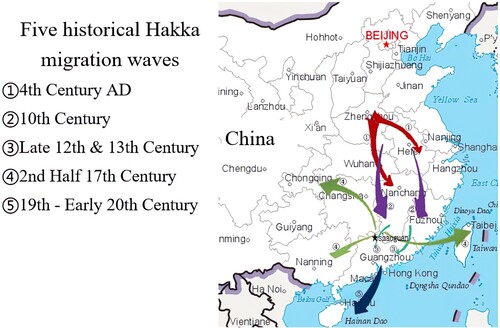ABSTRACT
Objectives
Shaokwan is one of the inhabitant regions of Hakka population in Guangdong province of southern China. Previous survey has reported that a higher prevalence of abnormal hemoglobin (Hb) in this region. However, large-scale survey on the molecular characteristics of abnormal hemoglobin in this south-north junctional region has not been reported.In this study, we aim to investigate the molecular characteristics of abnormal hemoglobin in this area.
Methods
Blood samples from medical check-up center in one local hospital were selected for abnormal hemoglobin screening. Hemoglobin electrophoresis and routine blood tests were performed. Hemoglobin variants were further analyzed by PCR and DNA sequencing.
Results
Among the 9731 study subjects, 45 cases of hemoglobin variants were found by hemoglobin electrophoresis, which gave an incidence of 0.46% (45/9731) in Shaokwan region. 8 kinds of hemoglobin variants were identified by gene sequencing. Hb Q-Thailand (16/45) was the most common hemoglobin variants, followed by HbE (7/45), Hb NewYork (6/45) and Hb G-Chinese (6/45).
Discussion and Conclusion
Hemoglobin variants had obviously genetic polymorphisms in Chinese. Our study of hemoglobin disorders in this special Hakka Chinese population will contribute considerably to our understanding of the historical, emigrational, and genetic relationships among different ethnic group in this region.
Introduction
Abnormal hemoglobin is an autosomal dominant inherited hemoglobin disorders that is caused by structural defects resulting from an altered amino acid sequence in α or β chains. Abnormal hemoglobin together with thalassemia syndromes is called hemoglobinopathies with a worldwide distribution, which is originally found mainly in the Mediterranean area and large parts of Asia and Africa [Citation1].
To date, more than 1403 kinds of hemoglobin variants were found all over the world (http://globin.bx.psu.edu/cgi-bin/hbvar/counter). Most of them showed no clinical presentation, and a few can cause illness, such as hemoglobin S (HbS) related sickle-cell disease and hemoglobin E (HbE) related thalassemia. The frequency of hemoglobin variants varied in different regions and different ethnic populations [Citation1,Citation2].
Hemoglobin disorder is prevalent in China, especially in southern China. From the end of 1970s to the early 1980s, the Chinese scientists performed a national wide survey for abnormal hemoglobin and thalassemia in China among 35 ethnic groups, involving more than 900,000 people in 28 provinces (autonomous regions and municipalities) [Citation3]. While information on the incidence of abnormal hemoglobin was available in the whole country, detailed data on the spectrum of abnormal hemoglobin in different regions and ethnic group was scarce. With the advance of technology, more accurate and rapid genotyping methods become possible.
The present study highlighted the detection of the abnormal hemoglobin by PCR-based DNA sequencing in Shaokwan, a central city in the north of Guangdong province. Shaokwan is a border area between Guangdong, Hunan and Jiangxi province of China, and is an important gate from south to north of China. 90% local people were mainly Hakka population. The previous survey has reported a higher prevalence of abnormal hemoglobin in this region [Citation4]. However, the genotypes of hemoglobin variants were not clarified, a large-scale survey on the molecular characteristics of abnormal hemoglobin in this south–north junctional region has not been reported.
In this study, we undertook a large-scale survey of abnormal hemoglobin in one local hospital in Shaokwan to get a better understanding of the prevalence and molecular characterization of abnormal hemoglobin in this region.
Material and methods
Study population and sample collection
The study was performed from November 2011 to May 2012. All the study subjects were from medical check-up center in Yuebei People’s Hospital, who visited the hospital for routine check-up including routine blood tests. After the routine blood tests were performed for a medical reason, the remaining blood samples were used for hemoglobin variants screening. A total of 9731 healthy local individuals attended this abnormal hemoglobin screening. This study was reviewed and approved by the Ethics Committee of Yuebei People’s Hospital Affiliated to Shantou Medical College and Chaozhou Central Hospital Affiliated to Southern Medical University.
Hematological analysis
About 2–3 ml of intravenous blood was collected in EDTA tube. Red blood cell (RBC) indices were measured on a hematology counter. Hb electrophoresis on cellulose acetate at pH 8.9 was done in all cases. The results of electrophoresis were classified as the ‘fast’ hemoglobin and ‘slow’ hemoglobin, including hemoglobin H, J, K, Bart’s, Normal, F/Q, G/D and E [Citation5].
Molecular analysis of hemoglobin variants
DNA was extracted from samples with abnormal electrophoresis results. The α1 and α2 globin genes were then amplified by PCR and sequenced. PCR reactions were performed on the MJ Mini Personal Thermal Cycler (Bio-RAD Company). Two pairs of previously reported effective PCR primers were used for α1 and α2 globin genes amplification [Citation6]. Approximately 100 ng of genomic DNA was amplified in a total volume of 50 μl containing 25 pmol of forward and reverse primers, 1 mM MgCl2, 200 μM of each dNTP, 2.5 U LA Taq polymerase (TaKaRa, Dalian, China) in 1 × dimethyl sulfoxide (DMSO) buffer, 32 mM (NH4)2SO4, 134 mM Tris-HCl at pH 8.8, 20% DMSO and 20 mM β-mercaptoethanol with 0.7 M betaine. The reaction condition was 95°C for 10 min, followed by 35 cycles of 95°C for 1 min, 58°C for 1 min, 72°C for 1.5 min, with final extension at 72°C for 10 min. The α2 (880 bp) and α1 (880 bp) gene fragments were sequenced by an ABI 377 automated sequencer (Applied Biosystems, Foster City, CA) with the same primers detailed in the previous study [Citation6].
Primers for β-globin gene amplification were described previously [Citation6]. PCR reactions were performed. After initial denaturation at 95°C for 3 min, 35 cycles of PCR (95°C for 30 s, 57°C for 30 s and 72°C for 1 min) were performed. DNA sequencing was performed by the ABI 3700 automated sequencer.
Hb E was confirmed by a thalassemia gene chip (Chaozhou Hybribio Limited Corporation, China) [Citation7].
Statistical analysis
Statistical analysis was conducted with SPSS 16.0 statistical software. Gene frequencies of these alleles were calculated by using the Maximum Likelihood method. Hardy-Weinberg equilibrium was used to compare the observed and expected genotypes in this study. The chi-square test was used to compare the distribution of various alleles causing abnormal hemoglobin in Shaokwan and other areas in China.
Results
In this study, 45 cases of hemoglobin variants were found by hemoglobin electrophoresis. The incidence of abnormal Hb was 0.46% (45/9731) in Shaokwan region.
These 45 cases of abnormal hemoglobin could be divided into five groups (Q group, J group, G/D group, E group and K group). Q group (35.6%, 16/45) was the main type of abnormal hemoglobin in this region, followed by G/D group (9/45), E group (7/45), J group (7/45) and K group (6/45).
All these 45 cases of hemoglobin variants were sequenced. 25 cases were α-globin gene mutation, and 20 cases were β-globin mutation. It gave frequencies of 1.285×10−3 and 1.028×10−3 for α-globin chain and β-globin mutations, respectively. Compared by the chi-square test, the observed and expected genotypes in this study were consistent with Hardy Weinberg equilibrium law (p = 0.819, p > 0.05).
9 genotypes of hemoglobin variants were found in this region. Hb Q-Thailand (16/45) was the main genotype of hemoglobin variants, followed by Hb E (7/45), Hb New York (6/45), Hb G-Chinese (6/45) and Hb G-Coushatta (3/45). Hb J-Bangkok and Hb J-Broussais were also found in this area. Both Hb Ottawa and Hb G-Taipei were only found in one case (). The DNA sequencing results of 8 types of abnormal hemoglobin (except Hb E) were shown in .
Figure 1. Sequencing results of eight kinds of hemoglobin variants. The mutation sites were indicated by arrows. A: Hb Q-Thailand (HBA1:c.223G > C); B: Hb G-Chinese (HBA2:c.91G > C); C: Hb J-Broussais (HBA2:c.273G > T); D: Hb G-Taipei (HBB:c.68A > G); E: Hb Ottawa (HBA1:c.46G > C); F: Hb New York (HBB:c.341T > A); G: Hb G-Coushatta (HBB:c.68A > C); H: Hb J-Bangkok (HBB:c.170G > A).

Table 1. The 45 cases of hemoglobin variants detected by electrophoresis and gene sequencing.
Discussion
This was the first large molecular investigation of abnormal hemoglobin in Shaokwan area, northern Guangdong province of southern China. In this study, 9731 subjects attended the screening programs for hemoglobin variants and the incidence of Hb variants was 0.46%. The incidence reported in this study was the same as that reported for this area 30 years ago [Citation4]. Comparing the prevalence of hemoglobin variants in Shaokwan with other areas in China, the frequency of hemoglobin variants in the Shaokwan region was equal to the average frequency of 14 provinces in the southern region of the Yangtze River (0.367%, P = 0.322) including Guangdong province (0.396%, P = 0.446), but was higher than the average level of 15 provinces in the northern region of the Yangtze River (0.290%, P = 0.049) [Citation3,Citation8–10]. In all, the frequency of hemoglobin variants in Shaokwan region was only secondary to Yunan province (5.94%, P = 0.000) for the whole China [Citation8,Citation9]. Furthermore, the incidence was similar to that report for the neighboring Meizhou region, which was another inhabitant region for Hakka population [Citation10].
Hakka is a distinctive Han Chinese population in Southern China, who speaks Hakkanese. According to historical records, it’s now commonly thought that Hakka population has originated from the lands bordering the Yellow River (the modern northern Chinese provinces of Shanxi, Henan, and Hubei). In a series of migrations, the Hakkas moved and settled in their present areas in Southern China [Citation11,Citation12], (a). Similarly, increasing genetic study on the Hakka population has revealed that the major gene element of the Hakka was Han Chinese from the south, with portions coming from the north [Citation13,Citation14].
It has been reported that hemoglobin variants had obviously genetic polymorphisms in Chinese [Citation3]. The genotypes of hemoglobin variants were significantly different between the southern and northern region and varied in different ethnic groups [Citation8,Citation15]. Hb E, Hb New York, Hb G Chinese, Hb Q Thailand and Hb J Bangkok were mainly found in southern China, Hb G-Coushatta and Hb G-Taipei were mainly found in northern China [Citation9,Citation16–18]. Our previous study of abnormal hemoglobin in Meizhou Hakka population also demonstrated that Hakka people had a more genetic composition of the northern Han population than other people in Guangdong province [Citation10]. Comparing the distribution of hemoglobin variants between Shaokwan and Meizhou region, they were very similar in genotypes, both showing a particular gene flow confluence between south China and north China. Therefore, we speculated that the Hakka people in Shaokwan and Meizhou regions might originate from the same ancestors who migrated from central plains to the southern part of China.
More interestingly, our study showed that Q group was the main group in this region, it was not E group, which was different from previous study in the same region [Citation4]. More Q group was found in this study than previous study of the same region. As expected, the genotyping results also revealed that Hb Q-Thailand was the most common hemoglobin variants in this region. Hb Q-Thailand was first reported in one Chinese family in Singapore in 1958 [Citation19]. Thereafter, it was found in Thailand, Japanese and China [Citation20]. although Hb Q-Thailand has been only described in Chinese and southeast Asian populations, data on its origin and spread remained to be elucidated.
Previous studies in China have observed that Hb Q-Thailand was mainly distributed in the area where the Hakka population inhabited, therefore, it has hypothesized that Hb Q-Thailand might originate from the Chinese Hakka population and spread to other populations in the world [Citation8]. Shaokwan was used to be called ‘Shaozhou’, known as ‘the fifth state’ for Hakka inhabitants, which was adjacent to the other three mainly inhabitant states (Ganzhou, Huizhou and Tingzhou) for the Hakka population study [Citation11,Citation12]. Thus, it was not difficult to explain the reason that so many Hb Q-Thailand were found in this study.
Nowadays, the Hakka population is spread all over the world, with a worldwide population estimated at 800 million. More than 50 million are found in 19 out of the 27 provinces in China. Guangdong province is the largest Hakka inhabitant region, 60% of the total Hakka population living in this region [Citation11,Citation12,Citation21], . Our genetic epidemiology study of abnormal hemoglobin had found that Hb Q-Thailand has a high detection rate in the two main Hakka inhabitant regions of Guangdong province-Shaokwan (0.16%) and Meizhou (0.085%) [Citation10]. Furthermore, there was no statistical significance of the prevalence of Hb Q-Thailand in Shaokwan, Meizhou (0.085%, 13/15229) and other Hakka inhabitant regions such as Huizhou (0.13%, 45/34977) [Citation22], Nanning (0.13%,45/34977) [Citation23] and Liuzhou (0.078%, 21/20167) [Citation24]. These data further supported the previous speculation that Hb Q-Thailand originated from the Hakka people in China.
Figure 3. The distribution of Hakka population in Modern China. (a) The main inhabitant region of Hakka in southern China. (b) The distribution of Hakka in Shaokwan and its neighboring cities.

In conclusion, our study had found a high frequency of abnormal hemoglobin variants, especially Hb Q-Thailand in Shaokwan city of Guangdong. In fact, our study of hemoglobin disorders in this Hakka inhabitant region will contribute considerably to our understanding of the historical, emigrational, and genetic relationships among different ethnic groups in different regions. Further large-scale investigation on this Hakka population in China will provide additional information related to the origin and spread of this variant.
Acknowledgments
This study was supported by Medical Research Fund of Guangdong Province (B2013444) and Natural Science Foundation of Guangdong Province (contract/grant number No.2016A030307035 to Li-Ye Yang).
Disclosure statement
No potential conflict of interest was reported by the author(s).
Additional information
Funding
References
- Weatherall DJ, Clegg JB. Inherited haemoglobin disorders: an increasing global health problem. Bull World Health Organ. 2001;79(8):704–712.
- Kohne E. Hemoglobinopathies: clinical manifestations, diagnosis, and treatment. Dtsch Arztebl Int. 2011;108(31-32):532–540.
- Zeng YT, Huang SZ. Disorders of haemoglobin in China. J Med Genet. 1987;24:578–583.
- Ren BZ, Liu Y. Disorders of haemoglobin in Guangdong province. part I a report on the investigation of abnormal haemoglobin among 83510 persons in some areas of Guangdong province (Mei-Zhou and Shao-Guan). Acta Jinan Univ. 1986;4:15–17. [In Chinese].
- Handoo A, Sood SK. Laboratory diagnosis of hemoglobinpathies and thalassemia syndromes. In: A Sachdeva, VK Khama, SP Yadav, etal, editors. Hemoglobinopathies. New Delhi, Jaypee Brothers Medical Publishers; 2006. p. 110–114.
- Lin M, Wang Q, Zheng L, et al. Prevalence and molecular characterization of abnormal hemoglobin in eastern Guangdong of southern China. Clin Genet. 2012;81(2):165–171.
- Lin M, Zhu JJ, Wang Q, et al. Development and evaluation of a reverse dot blot assay for the simultaneous detection of common alpha and beta thalassemia in Chinese. Blood Cells Mol Dis. 2012;48(2):86–90.
- Du RF. Population genetics of Chinese. Beijing: Science Publishing House; 2004, pp. 202-206. [In Chinese].
- Qin LY. The incidence, distributing and genetic polymorphism of the abnormal hemoglobin in China. Bull Med Res. 2003;32:12–14. [In Chinese].
- Lin M, Wen YF, Wu JR, et al. Hemoglobinopathy: molecular epidemiological characteristics and health effects on Hakka people in the Meizhou region, southern China. PLoS One. 2013;8(2):e55024.
- Luo XL. The origin of hakka. Beijing: China Overseas Chinese Publishing Company; 1989. [In Chinese].
- Zhong SH, Huang DQ. The spatial distribution and group characteristic of Chinese Hakkas. Guangxi Ethnic Studies. 2007;4:80–85. [In Chinese].
- Wang WZ, Wang CY, Cheng YT, et al. Tracing the origins of Hakka and chaoshanese by mitochondrial DNA analysis. Am J Phys Anthropol. 2010;141(1):124–130.
- Hu SP, Luan JA, Li B, et al. Genetic link between Chaoshan and other Chinese Han populations: evidence from HLA-A and HLA-B allele frequency distribution. Am J Phys Anthropol. 2007;132(1):140–150.
- Qin LY. The incidence, distributing and genetic polymorphism of the abnormal hemoglobin in China minority. Bull Med Res. 2004;33:39–40. [In Chinese].
- Lin M, Han ZJ, Wang Q, et al. Molecular epidemiological survey of Hemoglobinopathies in the wuxi region of Jiangsu province, eastern China. Hemoglobin. 2013;37(5):454–466.
- Huang H, Xu L, Chen M, et al. Molecular characterization of thalassemia and hemoglobinopathy in southeastern China. Sci Rep. 2019;9(1):3493.
- Xu A, Chen W, Xie W, et al. Hemoglobin variants in southern China: results obtained during the measurement of glycated hemoglobin in a large population. Clin Chem Lab Med. 2021;59(1):227–232.
- Vella F, Wells RH, Ager JA, et al. A haemoglobinopathy involving haemoglobin H and a new (Q) haemoglobin. Br Med J. 1958;1(5073):752–755.
- Singsanan S, Karnpean R, Fucharoen G, et al. Hemoglobin Q-Thailand related disorders: origin, molecular, hematological and diagnostic aspects. Blood Cells Mol Dis. 2010;45(3):210–214.
- Seminar on digital development of Chinese Hakka cultural content. Guangzhou: South China University of Technology Press; 2018. [In Conference].
- Zhong Z, Chen J, Guan Z, et al. [Phenotypic and genotypic analysis of 45 cases with Hemoglobin Q-Thailand]. Zhonghua Yi Xue Yi Chuan Xue Za Zhi. 2018;35(5):723–726. [In Chinese].
- Zhang Q, Fan X, Wei Y, et al. Genetic analysis on Hb Q-Thailand in Nanning city of Guangxi. Lab Med Clinic. 2014;20:2803–2804, 2807. [In Chinese].
- Huang C, Tang N, Lu BY, et al. Screening hemoglobin Q-Thailand combined alpha-thalassemia in Liuzhou region. Chin J Birth Health Heredity. 2017;25(11):26–27, 34. [In Chinese].

